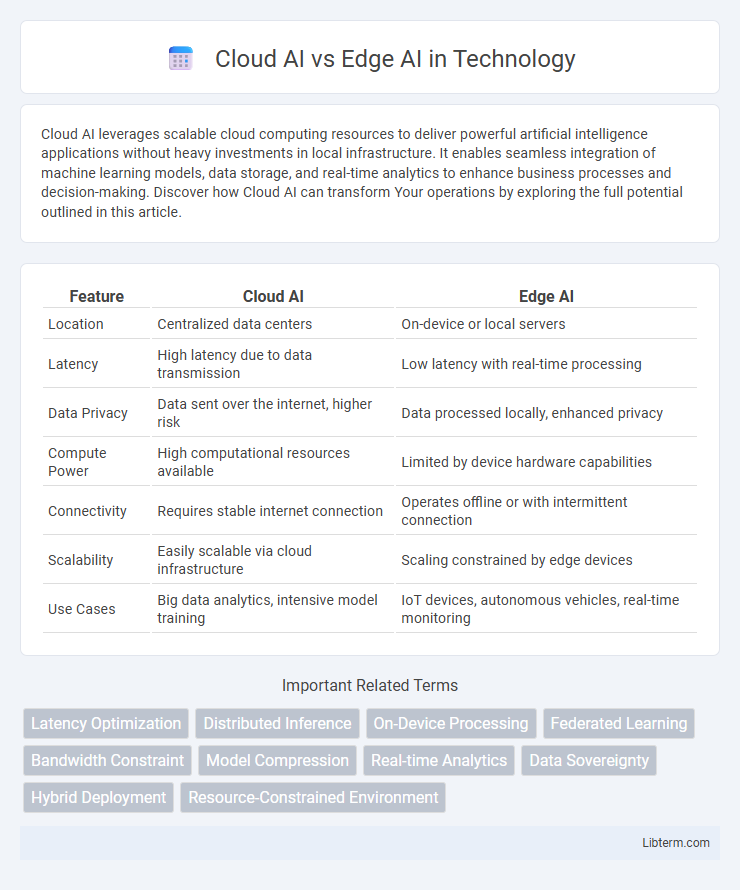Cloud AI leverages scalable cloud computing resources to deliver powerful artificial intelligence applications without heavy investments in local infrastructure. It enables seamless integration of machine learning models, data storage, and real-time analytics to enhance business processes and decision-making. Discover how Cloud AI can transform Your operations by exploring the full potential outlined in this article.
Table of Comparison
| Feature | Cloud AI | Edge AI |
|---|---|---|
| Location | Centralized data centers | On-device or local servers |
| Latency | High latency due to data transmission | Low latency with real-time processing |
| Data Privacy | Data sent over the internet, higher risk | Data processed locally, enhanced privacy |
| Compute Power | High computational resources available | Limited by device hardware capabilities |
| Connectivity | Requires stable internet connection | Operates offline or with intermittent connection |
| Scalability | Easily scalable via cloud infrastructure | Scaling constrained by edge devices |
| Use Cases | Big data analytics, intensive model training | IoT devices, autonomous vehicles, real-time monitoring |
Introduction to Cloud AI and Edge AI
Cloud AI leverages centralized data centers with vast computational power to process and analyze large datasets, enabling scalable machine learning and AI services accessible via the internet. Edge AI processes data locally on devices or edge servers, reducing latency and bandwidth use while enhancing real-time decision-making capabilities. Combining Cloud AI's extensive resource availability with Edge AI's on-device processing supports diverse applications from autonomous vehicles to smart IoT systems.
Key Differences Between Cloud AI and Edge AI
Cloud AI processes data on remote servers with extensive computational power, enabling advanced machine learning models and large-scale analytics. Edge AI performs data processing locally on devices near the data source, reducing latency and enhancing real-time decision-making for applications like autonomous vehicles and IoT devices. Key differences include data privacy, response time, network dependency, and infrastructure costs, with Cloud AI relying on consistent connectivity and Edge AI favoring decentralized, on-device processing.
Advantages of Cloud AI
Cloud AI offers extensive computational power and scalable resources, enabling complex data processing and large-scale machine learning model training. Its centralized infrastructure allows seamless software updates and integration with vast datasets from diverse sources. This environment supports advanced analytics and continuous model improvements, resulting in higher accuracy and more robust AI solutions.
Advantages of Edge AI
Edge AI offers significant advantages by processing data locally on devices, reducing latency and enabling real-time decision-making critical for applications like autonomous vehicles and industrial automation. It enhances data privacy and security by minimizing the need to transmit sensitive information to centralized cloud servers. Furthermore, Edge AI improves operational reliability in environments with limited or intermittent internet connectivity, ensuring continuous AI functionality without dependence on cloud access.
Data Processing: Cloud vs Edge
Cloud AI processes data centrally on powerful servers, allowing extensive computation, large-scale data integration, and continuous model updates but can introduce latency due to data transmission delays. Edge AI performs data processing locally on devices or edge servers, reducing latency, enhancing real-time decision-making, and minimizing bandwidth usage by handling sensitive data onsite. Hybrid approaches combine both, leveraging cloud for heavy analytics and edge for immediate processing to optimize efficiency and responsiveness.
Latency and Real-Time Performance
Cloud AI often experiences higher latency due to the data transmission between devices and centralized servers, impacting real-time performance in latency-sensitive applications. Edge AI processes data locally on devices or edge servers, significantly reducing latency and enabling faster decision-making crucial for real-time responsiveness. This local processing capability ensures minimal delay, making Edge AI ideal for applications like autonomous vehicles and industrial automation demanding immediate actions.
Security and Privacy Considerations
Cloud AI leverages centralized data centers, enabling robust security measures such as advanced encryption, real-time monitoring, and continuous updates, but it raises concerns over data exposure during transmission and reliance on third-party providers. Edge AI processes data locally on devices, significantly reducing latency and minimizing the risk of sensitive data breaches by limiting data transfer, yet it faces challenges in maintaining consistent security standards across diverse hardware. Ensuring secure authentication, data anonymization, and compliance with privacy regulations like GDPR are critical for both Cloud and Edge AI implementations to protect user data effectively.
Use Cases for Cloud AI
Cloud AI excels in large-scale data analytics, natural language processing, and complex machine learning model training due to its vast computational resources and scalability. It powers applications such as virtual assistants, fraud detection systems, and recommendation engines that require real-time data integration and continuous learning. Enterprises leverage Cloud AI for big data processing, predictive analytics, and AI-driven customer insights across industries like finance, healthcare, and retail.
Use Cases for Edge AI
Edge AI excels in real-time analytics and decision-making for autonomous vehicles, industrial automation, and smart surveillance where low latency is critical. It enables on-device processing for IoT sensors, wearable health monitors, and remote site equipment, reducing reliance on cloud connectivity and minimizing data transmission costs. Use cases include predictive maintenance in manufacturing, instant fraud detection in financial devices, and personalized user experiences in smart home systems.
Choosing the Right AI Deployment: Cloud or Edge
Choosing the right AI deployment hinges on specific application requirements such as latency, data privacy, and computational power. Cloud AI excels in handling large-scale data processing and complex model training with centralized resources, ideal for scenarios demanding high scalability and continuous updates. Edge AI offers low-latency responses and enhanced data security by processing information locally on devices, making it suitable for real-time applications and sensitive data environments.
Cloud AI Infographic

 libterm.com
libterm.com